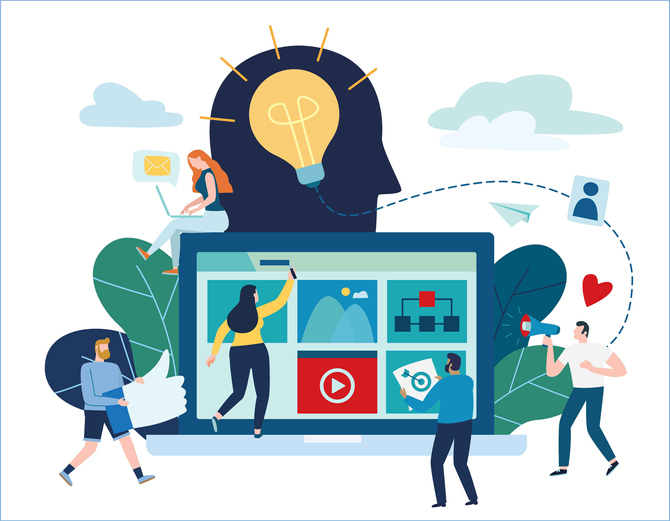The classroom is silent; all students look at their cell phones, laugh, and share their screens. How do we get their attention? It is a scenario that could scare any teacher. However, the students play and interact with class resources in the scenario described. What a relief! Later, they will apply what they have learned in practical cases of writing and text analyses. Therefore, didactic resources must vitally respond to students’ interests at all educational levels and types of study. Employing didactic content in various formats that encourage the practical implementation of knowledge serves to motivate students in their learning process. In my experience, digital educational resources are crucial in a Virtual Learning Environment (VLE). These resources enhance activities in all learning modalities, and teachers must know how to apply them.
Digital and analog educational resources have always accompanied us in the classroom through textbooks, presentations, music, applications, games, and videos. We find a great variety of tools and formats; however, choosing or creating these resources implies more than choosing a tool because it involves context and the purpose of learning.
“The students felt that developing a project with continuous help on the platform with resources and activities helped them to continue building with their projects in mind.”
What should we keep in mind?
The pandemic’s lessons in education alerted us to the significant impact that technologies have on creating flexible educational proposals for learning methodologies and modalities. Teachers began to understand the importance of designing, programming, and other technical aspects that affect the conceptual and didactic components of a learning experience. In the same way, in a virtual learning environment, we develop and design the space where interactions among the entire educational community occur, including learning activities and institutional and personal digital educational resources.
Four keys to choosing and creating digital educational resources:
- Clear and friendly language. This aspect allows us to transform digital environments and resources to make them closer, more exciting, and more practical. They are the wager we place on didactic transposition. Daniel Cassany (1993; 2021) is an excellent reference. In my class resources, this aspect stands out in the words I choose to communicate with students, using the word “you” to engage them, and in the examples I choose. Here are some of the resources created for my class: Common reading and writing errors.
- Visual aspect. The visual aspect complements the previous point and helps us to transmit other meanings in our environments and resources. Also, they enhance motivation and allow diverse approaches to knowledge. Therefore, I used escape rooms, a fun activity in many video games, as an approach in the course. Here is another example from my class: The academic article dungeon.
- Universal Design for Learning (UDL). This model allows us to reflect and create educational resources and digital environments considering diversity, different ways of learning, and equity. You can learn more about it here: DUA (Educational Technologies Service, Board of Extremadura; s.f.). Through digital resources, we can use various representations and interactions. Here is another example from my class: The keys to argumentation.
- The quality of resources. Finally, not all resources are suitable due to the existence of standards for purpose, context, usability, format, and many other aspects to consider when creating and using them in our teaching processes. I recommend the text, Más y mejores aprendizajes (More and better learning) (Mineducación, 2021) and digital teaching skills (INTEF, 2022).
My students, who are just beginning their university journey, find a friendly, straightforward, somewhat repetitive VLE whose structure invites autonomous exploration and an intuitive sequence that allows them to understand the proposed logic. Each activity is accompanied by digital educational resources that allow them to explore the concepts to review in class under the flipped classroom model. The subject I teach concerns communication and language, but these recommendations apply to any discipline.
This proposal aims to approach the learning platform and educational resources differently. The latter became an ace up my sleeve because they were a third mediator supporting me inside and outside the classroom. Students explored the virtual space and discovered various resources and activities that allowed the possibility to learn anywhere, at any time, and in different ways.
How did they experience it?
The students indicated feeling that the development of a project, with continuous help from the platform with resources and activities, helped them to continue building and thinking about their projects. They could choose between presenting an argumentative podcast or a short academic article. In both, the theme was open to the student’s interests; I propose that the students play an active role in the creation and research.
This work required leveraging Moodle to use all its diverse resources, such as H5P, tasks, activities, and forums. On the other hand, Genially was used to complement the interactive resources and Padlet for sharing and reflecting on the processes.
Students highlighted the practical aspect of the experience and the application of what they had learned in their academic and personal lives. The students built products throughout the semester and returned to interactive presentations, infographics, podcasts, videos, and escape rooms to review and improve their final delivery. The students continuously produced evidence and assessed it as proposed in the institution’s educational model following the didactic project-based learning strategy.
The reflective practice helped improve the activity’s instructions, develop more examples, and create educational resources suitable to respond to the diversity of ways to learn and read, thus developing the UDL, i.e., to continue developing the necessary digital competencies as teachers.
Organic digital resources and environments that live and evolve
This experience only emphasized the need for us, as guiding teachers and mediators, to be attentive to everything surrounding the learning process in any modality. It is especially worthwhile for us to reflect and design the space and resources that accompany us in constructing knowledge. This creation is alive because it achieves, mutates, learns, and transforms for students according to experiences and purposes.
Finally, I invite my colleagues to continue thinking about the experience that our students have and the possibilities we have to enrich their processes. If you want to build or share your experiences on these aspects, write to me in the email I share.
About the author
María Fernanda Urbano (mafe.urbano@hotmail.com) has a degree in literature from Universidad del Valle. She is a Specialist in the Pedagogy of Virtuality and a multimedia production technologist. Her master’s is in Cultural Studies. Her interests include reading, writing, digital educational resources and experiences, and culture and its relationship with the internet. She is also the leader of the pedagogical area of Uniajc Virtual at the Antonio José Camacho University Institution in Colombia.
References
Cassany, D. (1993). La cocina de la escritura. Barcelona. Anagrama.
Cassany, D. (2021). El arte de dar clase. Barcelona. Anagrama.
Servicio de Tecnologías Educativas. Junta de Extremadura. (s.f) Diseño Universal para el Aprendizaje (DUA). Recuperado de: https://emtic.educarex.es/creasite/recursos-crea/283-emtic/innovaredcat/3391-creadua
Mineducación (2021). Más y mejores aprendizajes. Colombia. Accessed from: https://www.colombiaaprende.edu.co/contenidos/coleccion/politica-publica-de-recursos-educativos
INTEF (2022). Marco de Referencia de la Competencia Digital Docente. Accessed from: https://intef.es/competencia-digital-educativa/competencia-digital-docente/
Editing
Edited by Rubí Román (rubi.roman@tec.mx) – Editor of the Edu bits articles and producer of The Observatory webinars- “Learning that inspires” – Observatory of the Institute for the Future of Education at Tec de Monterrey.
Translation
Daniel Wetta
This article from Observatory of the Institute for the Future of Education may be shared under the terms of the license CC BY-NC-SA 4.0 
)
)


)